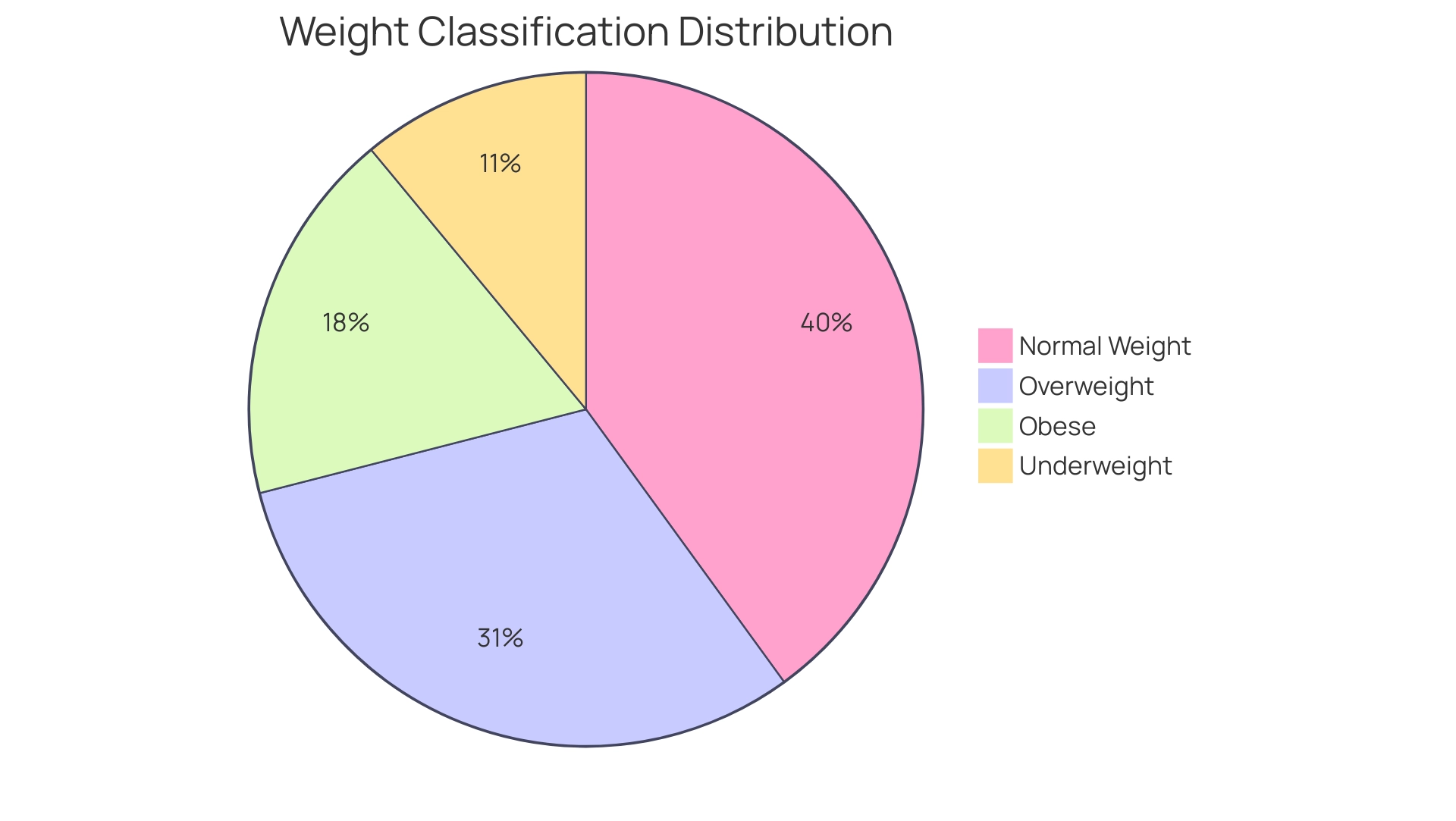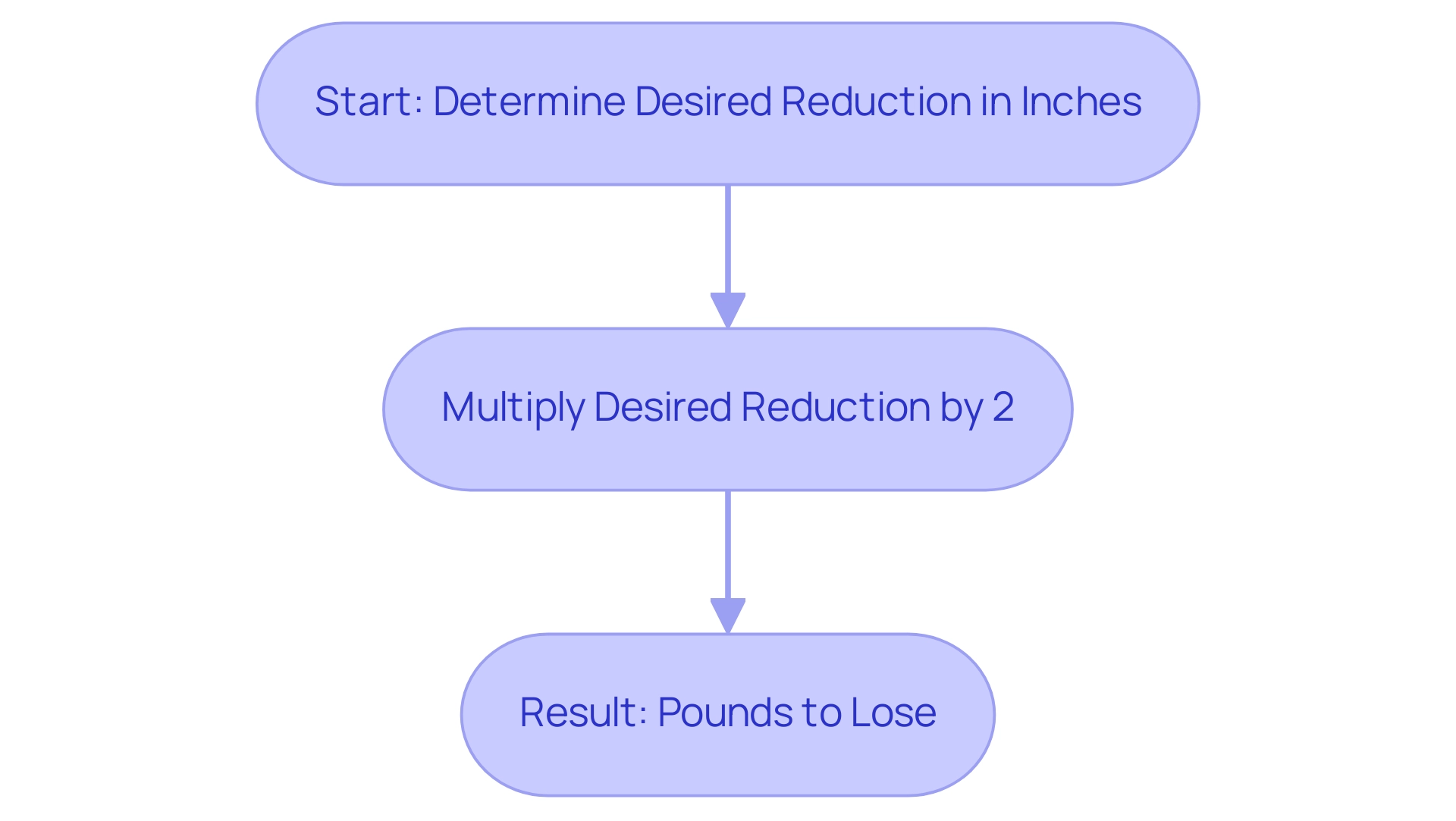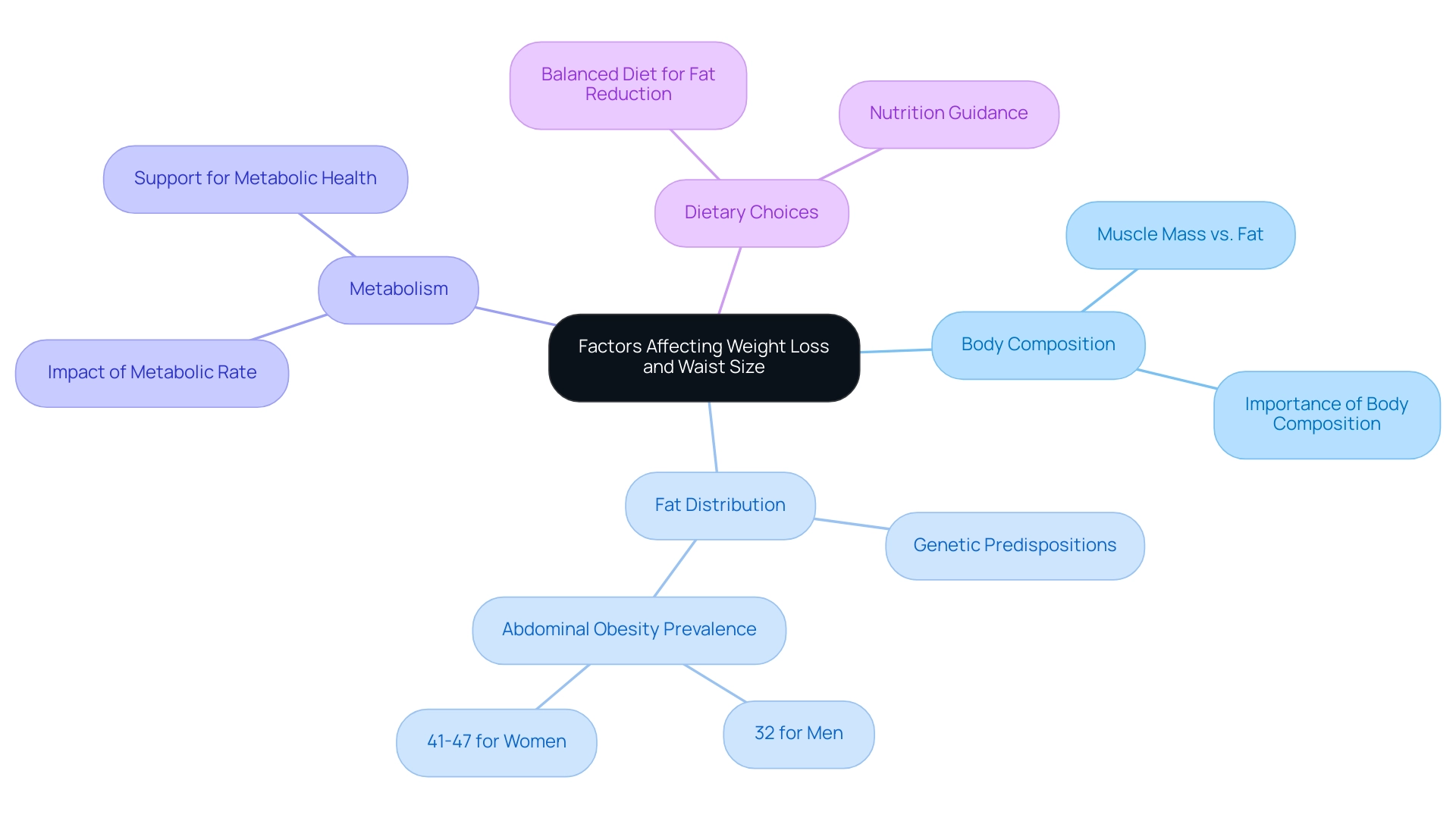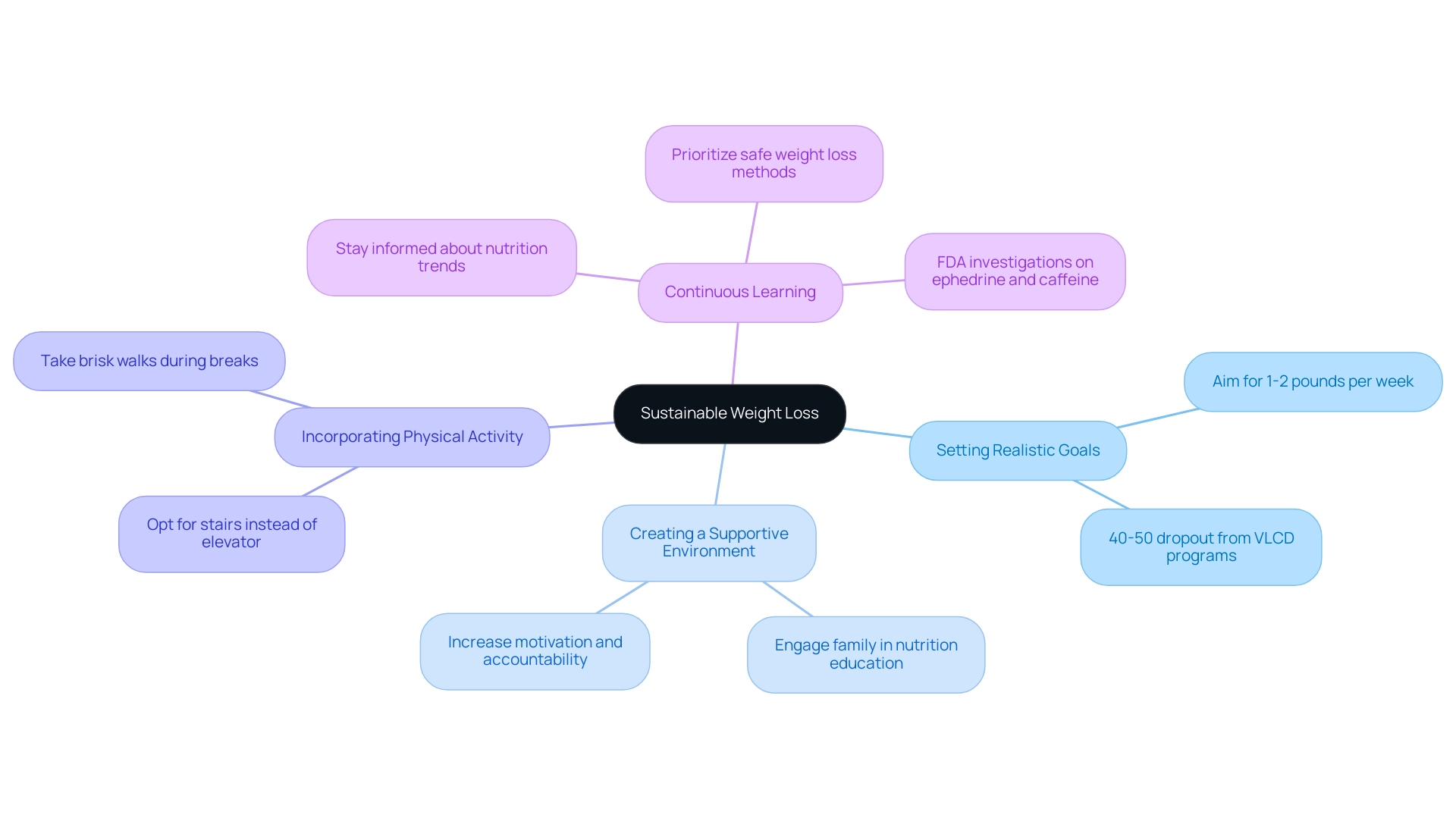Overview
To calculate how many pounds it takes to lose an inch from your waist, you generally need to lose about 2 pounds for every inch reduction in waist circumference. This guideline is supported by the article's explanation that a loss of approximately 0.5 inches in waist circumference corresponds to a 1-pound weight loss, emphasizing the importance of understanding this relationship for effective weight management.
Introduction
In the quest for better health, understanding the intricate relationship between weight loss and waist measurement emerges as a vital focus. While many strive to shed pounds, the significance of waist circumference often goes overlooked, despite its strong correlation with health risks. Research reveals that a reduction in waist size can lead to tangible weight loss, but the journey is influenced by a myriad of factors, from body composition to lifestyle choices.
As individuals seek effective strategies for achieving their fitness goals, incorporating waist measurement into their health assessments becomes essential. This article delves into the science behind waist size and weight loss, offering insights and practical guidance for those looking to navigate this complex terrain on their path to wellness.
Understanding the Relationship Between Weight Loss and Waist Measurement
Waist measurement serves as a crucial health indicator, particularly as it reflects the amount of abdominal fat—a significant factor linked to various health risks. Studies consistently indicate that for every 1-inch decrease in abdominal circumference, individuals can determine how many pounds does it take to lose an inch, which is approximately 0.5 to 1 pound, depending on several factors, including body composition and fat distribution. This relationship is vital for setting realistic weight loss goals and effectively tracking progress, especially in understanding how many pounds does it take to lose an inch.
Significantly, a study carried out as part of the Shanghai Women’s Health Study uncovered a concerning correlation: normal-weight women with larger girth measurements faced markedly increased mortality risks. This finding highlights the importance of including midsection measurement in health evaluations. In the context of the population, it is important to note that:
- 11% of individuals were found to be underweight
- 31% were overweight
- 18% were classified as obese
This highlights the significance of measurement around the midsection across different categories.
As Prof. von Haehling, a consultant cardiologist, poignantly noted,
The present findings raise the alarm over the term ‘obesity paradox’, which has been claimed to be based on BMI. Can we tell obese HF patients just to stay as they are?
This emphasizes the urgent need for nuanced approaches to understanding the implications of body circumference and management of mass.
Moreover, upcoming research should investigate possible confounders like snacking or alcohol intake during television viewing, as these elements could greatly affect body measurement and overall health results.

Calculating the Pounds Needed to Lose an Inch Off Your Waist
Comprehending the connection between body mass reduction and midsection decrease is vital for attaining fitness objectives. To determine how many pounds does it take to lose an inch off your midsection, consider the following guideline: for every pound lost, you can expect a reduction of approximately 0.5 inches in circumference. This means that to determine how many pounds does it take to lose an inch, you would need to lose about 2 pounds.
For instance, if your current measurement around the midsection is 36 inches and your target is 34 inches, a weight loss of roughly 4 pounds would be necessary to reach that goal. According to the case study on Average Midsection Size and Health Indicators, the average midsection size for American women is around 38.7 inches, which is an important health indicator. However, individual body composition can significantly influence these outcomes.
It’s crucial to track your progress consistently and adjust your strategies as needed. Kimberly Holland, an experienced author, stresses:
- What’s important is understanding how these figures, including your hip size, can help you shape a healthier future.
Additionally, medications like Ozempic and Mounjaro have become popular options for weight loss, highlighting the importance of staying informed about current solutions.
By focusing on sustainable changes rather than quick fixes, you can maintain your progress and foster long-term health. For a practical calculation, the formula for determining how many pounds does it take to lose an inch off your midsection is:
(Desired Reduction in Inches) x 2 = Pounds to Lose
Therefore, to figure out how many pounds does it take to lose an inch from your midsection, aim to lose approximately 2 pounds.

Factors Affecting Weight Loss and Waist Size
The connection between loss of mass and changes in hip size is affected by several interconnected elements:
- Body Composition: Individuals with greater muscle mass may see a more notable decrease in inches relative to pounds lost, as muscle tissue is denser than fat. This emphasizes the significance of concentrating on body composition instead of merely weight, particularly in understanding how many pounds does it take to lose an inch, a focus backed by our wellness coaching app that offers personalized workouts designed for specific fitness levels.
- Fat Distribution: Genetic predispositions play a crucial role in determining fat storage patterns, which can significantly affect changes in body measurement. For instance, studies indicate that the prevalence of abdominal obesity is around 32% for men and 41% to 47% for women, depending on the measurement protocol used. This highlights the necessity to account for individual differences in fat distribution when assessing body size. Our app helps users track these changes effectively.
- Metabolism: An increased metabolic rate can speed up fat reduction, which can help answer the question of how many pounds does it take to lose an inch in body size. Individuals with faster metabolisms may observe how many pounds does it take to lose an inch in body circumference as they lose weight. The app's daily programming feature ensures that users stay on track with their goals, supporting metabolic health and maintaining motivation through structured guidance.
- Dietary Choices: The kinds of foods eaten are essential for fat reduction and muscle preservation. A balanced diet that aids in muscle maintenance while encouraging fat reduction can help determine how many pounds does it take to lose an inch in circumference. Our nutrition guidance within the app empowers users to make informed dietary choices. As R. Kelishadi observes, comprehending these elements enables people to customize their reduction strategies more effectively. In clinical contexts, it is recommended that circumference around the abdomen is measured alongside BMI to enhance the identification of individuals at risk for cardiometabolic morbidity and mortality, especially for those with lower BMI but elevated abdominal measurements. Our wellness coaching app emphasizes this dual approach, improving risk stratification and promoting personalized health interventions through one-on-one coaching and community support. By consolidating various wellness resources in one user-friendly platform, the app simplifies the wellness journey, making it easier for users to manage their health goals.

Effective Strategies for Losing Weight and Inches
To achieve effective weight loss and reduce inches from your waist, consider implementing the following personalized strategies that emphasize experienced guidance and active engagement:
- Balanced Diet: Prioritize a diet abundant in whole foods, such as fruits, vegetables, lean proteins, and whole grains. Minimizing processed foods and sugars is essential, as these can lead to increased mass and obstruct fat reduction efforts. Recent studies suggest that tailored dietary approaches, considering demographic factors and self-reported food preferences, may enhance results. Tailored coaching can assist people in discovering the most effective dietary approaches for their specific requirements. One pleased client remarked, "With the assistance of my coach, I found foods that I enjoy and that aid in achieving my fitness objectives!"
- Regular Exercise: A combination of cardiovascular and strength training exercises is essential. Aim for at least 150 minutes of moderate-intensity aerobic activity each week, alongside strength training on two or more days. Notably, sprint interval training has demonstrated remarkable effectiveness, assisting people in losing nearly 40% more body fat than traditional high-intensity interval training (HIIT) while requiring over 60% less time commitment. As noted, "Sprint interval training is an incredibly effective form of exercise that has been shown to help people lose 39.95% more body fat than HIIT, with 60.84% less time spent exercising." Personalized fitness programs led by experienced coaches can maximize the effectiveness of these workouts. A client remarked, "My coach tailored my workouts to fit my schedule and goals, making it easier to stay on track."
- Hydration: Staying well-hydrated is vital for metabolism and curbing cravings. Consuming sufficient water can aid your management efforts, making hydration a frequently neglected element of successful body reduction. Personalized guidance can help individuals establish hydration goals that fit their lifestyle.
- Mindful Eating: Engage in mindful eating practices by tuning into your hunger cues and minimizing distractions during meals. This approach can prevent overeating and promote a healthier relationship with food. Experienced coaches can provide valuable techniques to enhance mindfulness in eating habits. One client noted, "Learning to eat mindfully has completely changed my relationship with food."
- Sleep and Stress Management: Never underestimate the effect of sleep and stress on your journey to reduce body mass. Prioritizing quality sleep and developing effective coping mechanisms for stress can significantly influence your overall health and also help you understand how many pounds does it take to lose an inch. Personalized support can help individuals create tailored strategies for better sleep and stress management.
Incorporating these personalized strategies, along with ongoing self-monitoring and meal planning, can promote sustainable management of body mass and waist reduction. As trends in diet and exercise continue to evolve, concentrating on these foundational elements, backed by knowledgeable coaching, will be essential to achieving and sustaining your fitness objectives.
Ready to take control of your health and well-being? Contact us today to schedule a consultation and start your journey towards a better you!

The Role of Lifestyle Changes in Sustainable Weight Loss
Sustainable reduction in body mass transcends temporary dieting; it requires a commitment to lasting lifestyle changes. To effectively navigate this journey, consider the following essential strategies:
- Setting Realistic Goals: Aim for a gradual reduction of 1-2 pounds per week. This approach is healthier and more sustainable, especially considering that approximately 40 to 50 percent of patients abandon very-low-calorie diet (VLCD) programs due to their limited long-term effectiveness and potential side effects.
- Creating a Supportive Environment: Engage with people who foster healthy habits and accountability. Research shows that including family members in nutrition education greatly increases the chances of sustained reductions in body mass and encourages healthier eating practices within the home. Family involvement increases motivation and accountability, which are crucial for long-term success.
- Incorporating Physical Activity into Daily Life: Look for opportunities to increase daily activity. Simple changes, such as opting for the stairs instead of the elevator or taking a brisk walk during lunch breaks, can make a substantial difference.
- Continuous Learning: Stay informed about the latest nutrition and fitness trends. Being adaptable and willing to modify your strategies is essential for long-term success. Additionally, it's important to prioritize safe methods for losing pounds; for example, while the combination of ephedrine and caffeine has shown significant results in loss, safety concerns have led to FDA investigations, raising the question of how many pounds does it take to lose an inch through safe practices.
By adopting these lifestyle changes, individuals can not only achieve loss but also enhance their overall health and well-being. As Sam Phoenix aptly noted, 28% of people attempt to lose weight for their family, illustrating the powerful motivations behind these changes.

Conclusion
The intricate relationship between weight loss and waist measurement is essential for achieving and maintaining health. Understanding that waist circumference is a significant indicator of health risks can guide individuals in setting realistic goals and tracking their progress effectively. Research highlights that a reduction in waist size correlates with weight loss, emphasizing the importance of incorporating waist measurement into health assessments. This nuanced approach reveals that factors such as body composition, fat distribution, metabolism, and dietary choices play pivotal roles in determining success on the weight loss journey.
Implementing effective strategies—including:
- A balanced diet
- Regular exercise
- Hydration
- Mindful eating
- Stress management
can lead to sustainable weight loss and waist reduction. The emphasis on gradual, realistic goals fosters a healthier mindset, while a supportive environment enhances motivation and accountability. As individuals engage in lifestyle changes that prioritize overall well-being, they not only work towards their fitness goals but also cultivate a healthier relationship with their bodies.
Ultimately, recognizing the significance of waist measurement alongside weight can empower individuals to make informed decisions about their health. By embracing a holistic approach that combines education, personalized strategies, and supportive resources, the path to wellness becomes clearer and more achievable. Now is the time to take control of health and make these vital changes for a healthier future.
Frequently Asked Questions
Why is waist measurement important for health?
Waist measurement serves as a crucial health indicator as it reflects the amount of abdominal fat, which is linked to various health risks.
How many pounds does it take to lose an inch off the waist?
For every 1-inch decrease in abdominal circumference, individuals can expect to lose approximately 0.5 to 1 pound, depending on factors like body composition and fat distribution.
What is the significance of the findings from the Shanghai Women’s Health Study?
The study found that normal-weight women with larger girth measurements faced increased mortality risks, emphasizing the importance of including waist measurement in health evaluations.
What percentage of individuals fall into different weight categories according to the article?
According to the article, 11% of individuals were underweight, 31% were overweight, 18% were classified as obese, and 40% were considered normal weight.
What is the guideline for losing inches from the midsection?
To lose an inch off the midsection, you would need to lose about 2 pounds, as for every pound lost, you can expect a reduction of approximately 0.5 inches in circumference.
How can I calculate how many pounds I need to lose to achieve my waist measurement goal?
To determine how many pounds you need to lose to achieve your desired waist measurement, use the formula: (Desired Reduction in Inches) x 2 = Pounds to Lose.
What is the average midsection size for American women?
The average midsection size for American women is around 38.7 inches, which serves as an important health indicator.
What should I consider while tracking my weight loss progress?
It’s crucial to track your progress consistently and adjust your strategies as needed, while also considering factors like hip size to help shape a healthier future.
What are some current medications mentioned for weight loss?
Medications like Ozempic and Mounjaro have become popular options for weight loss, highlighting the importance of staying informed about current solutions.
What is the overall approach suggested for weight loss?
The article emphasizes focusing on sustainable changes rather than quick fixes to maintain progress and foster long-term health.

